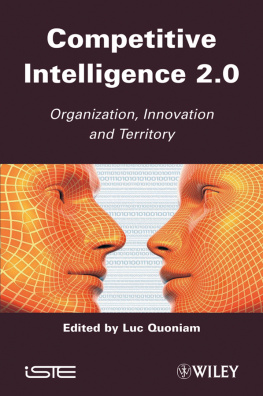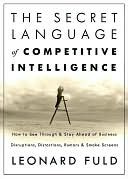First published 2011 in Great Britain and the United States by ISTE Ltd and John Wiley & Sons, Inc.
Apart from any fair dealing for the purposes of research or private study, or criticism or review, as permitted under the Copyright, Designs and Patents Act 1988, this publication may only be reproduced, stored or transmitted, in any form or by any means, with the prior permission in writing of the publishers, or in the case of reprographic reproduction in accordance with the terms and licenses issued by the CLA. Enquiries concerning reproduction outside these terms should be sent to the publishers at the undermentioned address:
The rights of Luc Quoniam to be identified as the author of this work have been asserted by him in accordance with the Copyright, Designs and Patents Act 1988.
Competitive intelligence 2.0: organization, innovation and territory / edited by Luc Quoniam.
p. cm.
Includes bibliographical references and index.
1. Business intelligence. 2. Information technology. I. Quoniam, Luc.
The 21st Century has proclaimed the arrival of a developed world, which is filled with hope and opportunities. However, this century is also full of challenges. Indeed, the information globalization context has influenced the vision of the world in a new way.
This book, Competitive Intelligence 2.0, is a welcome development, as it addresses an elusive field which impresses itself in the economy, social studies, environmental issues, territorial development, innovation, knowledge, etc. Moreover, it is intended to occupy a privileged position as a creativity tool.
Information and world network systems are evolving. From the first generation system, which was predominantly related to the passive storage of information, we are evolving toward a second generation system in which methods, tools, and applications give users new perspectives. This development is generally associated with the suffix 2.0 and testifies to the new capabilities of applications, which should be combined with the countless ways of improving organizational and individual strategies.
For example, technological information processing especially through evolution of bibliometric methods opens new perspectives for innovation. In addition, the progress made in China in translation techniques plays a pivotal role in exchanges between nations, organizations, and individuals.
Thus, the wide variety of topics presented and discussed in this book will offer a broad vision of new aspects of competitive intelligence. The readers will find original articles, as well as relevant bibliographic references, in this book. They will also find various ways of introducing different aspects of Competitive Intelligence 2.0 in their professional practices.
Finally, the decision-maker will be able to develop, without any doubt, the interest in adopting the recommended perception (both sharpened and broadened), allowing us to contemplate the world from the viewpoint of sustainable development and the evolution of values in light of the changing economic models and innovation processes.
This indispensable book should be considered as the domain reference of Competitive Intelligence 2.0.
Zhouying JIN
June 2011
Pr Zhouying JIN is the holder of the chair of the Beijing Academy of Soft Technology.
From the recognition of the disciplinary field of competitive intelligence in the 1990s to the emergence of Competitive Intelligence 2.0, we have witnessed and contributed to the development of tools, practices, and new theoretical approaches based on the current well-established paradigm of many-to-many communication. This book is part of the studies conducted by a team, where the team is endowed with 20 years of observations and experiments, from the creation of the first postgraduate degree course dedicated to information (for the benefit of decision-making) in 1989, to the creation of a Research Laboratory 2.0 Lab4u in 2009. The 2.0 concept calls thenceforth for the emergence of a new emanticipated Web model with applications in all areas of social activity: management, innovation, education, organization, territorial planning, etc. This book aims to examine the implications of this paradigm shift on competitive intelligence and propose research perspectives.
In the beginning there were semiconductors
Moores conjecture in the 1960s described the evolution of semiconductor capability, which doubles each year at a constant cost. Machrones economic law later indicated that the price of a computer was still, in effect, determined by the consumer irrespective of changes in its technical capabilities. Despite the limitations and contestations witnessed by these economic models, we could, however, observe a continuous increase in the capacity of equipment available to the public for an ever-decreasing cost, which bodes well for a democratization of access to this evolving medium. The promises offered by these technologies were indications of a real change in the world. Graphical interfaces and hypertext navigation brought out tangible changes, and since 1994, each calendar year corresponded to seven technological years thereby receiving the appellation dog years. This phenomenon is rapidly increasing and a year might correspond to even 10, 20, or 30 years!
This phenomenon can be viewed from several angles; the most simple can be illustrated by the amount of information published annually on the Web, an order of magnitude of several exabytes (1018 bits). Considering that a 500-page book represents 1 megabyte (106 bits), this quantity is incomparable with the storage capacity of man, which is inferior.
In addition, new features offered by these technologies should be adopted. For example, it is now possible to communicate freely in all languages; this was something unimaginable a few years ago. With language barriers collapsing, competitive intelligence intends to capture knowledge and cultural domains which have been inaccessible so far. Learning these new possibilities and new functioning modes of our society is a complex phenomenon, since it surpasses the updating capabilities of teachers, as well as professionals. The result of this evolution is the emergence of a new Concept 2.0.
User generated contents versus Publisher contents
The expression Web 2.0, initially used by Darcy Di Nucci in 1999, refers to the second generation of Web design and development. Tim OReilly related this appellation, in 2004, to the idea of cumulative changes in the development of the Internet, as well as its new uses. Compared to 2.0, the early days of the Internet looked like a fake revolution. It was a replication of the traditional information publishing model, where content produced by someone (a knowledge holder) was imposed and addressed to others, despite the proclaimed possibility that everyone could publish themselves. Therefore, traditional media models (television, radio, etc.) based on vertical communication remained.
A fundamentally different model emerged with about 240 million Websites, in June 2009, and imposed its hegemony. The horizontal communication paradigm, i.e. many to many was henceforth dedicated and welcomed with new uses. Two types of phenomena had appeared simultaneously. On the one hand, the vertical communication (one to many) model gave way to a horizontal communication model of many to many (n to n) in which a speaker doubles as a facilitator. This is the extension of peer-to-peer functioning in the organization of our societies; network technical architecture transposing into social interactions. On the other hand, this flattening of social relations, under the influence of the technical architecture of networks, was accompanied by a community phenomenon.








